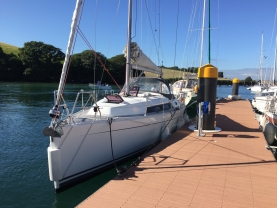
Safely moored in 'The Bag' in Salcombe visitor moorings, Salcombe, Devon, England. (50º 14.61′ N, 03º 45.57′ W)
THE SAILING LOG BOOK - by Passage Planners
The sailing log book is a document considered to be an essential part of the sailing passage and many words have been written about it. We will try to be brief in our explanation of its importance and content.
Regulation V/28 of the International Convention for the Safety of Life as Sea (SOLAS) 1974, requires all vessels to keep a navigation log by law. So it is an important legal document. Be aware that, in the event of an accident or series incident at sea, the first thing the authorities will want to see is the Log Book. This is true for most European countries and heaven forbid if you are not able to produce one. So it is a legal requirement as well as a sensible document to maintain.
All this scary stuff aside, the log book is an essential document used in navigation and safe passage making and will be a record of your passage and relevant points of note which should be recorded prior to and during your voyage. Include your departure details and landfall details with particular reference to navigation items such as position of entry/safe water buoys, lighthouse name, time of landfall, weather, sea and wind condition at that time.
It is used to make records of, for instance; course steered, distance covered, leeway, weather forecasts, barometer readings, record fixes, wind direction and speed, sail plans, watch changes, maintenance checks prior to and during passage particularly relating to batteries, water, engine use and consumption of fuel. Sea state, weather changes and wind changes are also important events to record. Other relevant detail need also to be recorded such as en-route incidents.
Many skippers, including us, will also record that they have delivered a safety briefing to their crew and include the crew names on the Log. Other passengers (non crew) will be recorded also. Any unexpected and/or unusual events happening during passage will also be noted which may include, for instance, other ship movements nearby.
The Log needs to be updated generally on a minimum hourly basis, however any significant event should be noted in the interim period.
OUR SAILING LOG BOOK DESIGN
Our Sailing Logbook has been well received and here are a few comments from our customers:
The seller provided excellent communication throughout and the item arrived in good time and was well-packaged. The Sailing Log Book really is an excellent product, well-made and a really excellent resource. I will have no hesitation ordering from this seller again.
(Passage Planners - Sailing Log Book) ........ Karen J.
Quick delivery but also an excellent logbook. Much better than I expected and will do a great job logging my leisure sailing trips. (Passage Planners - Sailing Log Book) ............. David L Master Mariner.
Many years ago, following our sailing qualifications and our sailing adventure commencement, we purchased an ‘off the shelf’ logbook which we soon realized was not really suitable for our use. We found that too much space was wasted relating to entries which just did not require the space allocated. We also noted that the pages were quite thin and not really suitable for us (we use 200 gsm paper). Eventually we started to design our own single sheets which were more useful to us and we subsequently edited our headings to make a quick and easier format to record our entries.
Over a period of time, and once we were satisfied that we had a good functioning log book, we produced wire bound books with strong acetate covers, containing the log book sheets which we also made sure were individually numbered. We offer our log book design to fellow sailors in the hope that they will also find the layout to their liking. The log books also benefit from the fact that the individual pages are in a ‘lay flat’ position. Many traditional bound log books do not have this benefit and it can be really annoying, particularly when entering details when below deck, in a sea way! Incidentally, we do not recommend the use of the log book above deck. Weather and sea conditions can destroy such documents! If the log book really does need to be on deck then we recommend that it be kept in a waterproof case. We have used our design of log book for some years now and offer it as a very suitable and easy way of recording your passage.
Why number the log book entry sheets?
Log books are legal documents and If they are produced on paper (almost all are), they should be kept in a book with numbered pages. Any entry error made in the completion of a log book should be crossed out and not erased. Use a single horizontal line and initial the correction. If, heaven forbid, the log book becomes a document to be produced in a law court, then the erasure of detail and/or removal of pages could be challenged in court.
Also it is essential to be able to access the log book at a moments notice, and remember to include it in your 'ditch kit' if you need to abandon your boat !!!
Our recommendation would always be not to purchase a sailing log book where the relevant entry pages are not numbered.
Our sailing log book has 60 individually numbered Log book entry pages and includes a page for insertion of your boat's Call Sign and MMSI Number. We also include a page for you to insert your Vessel Details. Generally each log bok is sufficient for a minimum of one to two years active cruising for most sailors.
Thus, we present our Sailing Log Book for sail and power yachts to you as a professional and easy to use document for coastal and off-shore passages, and with the confidence that the entries are suitable for your purpose, and we sincerely hope that waste space is non-existent.
Our Sailing Log Book is suitable for both Sail and Power yacht passages.
In closing, have a look online at other log books for sale. Many of them do not reveal anything other than the cover, and do not show any entry detail pages. Thus, you have no idea what they contain. Why would a publisher try to sell a Sailing log book by showing only the front cover? Why on earth would you want to buy a sailing log book if you didn't know what entry headings were included, or indeed whether it was likely to be to your satisfaction? Of those which do show some of the inside entry pages, many are clearly and woefully inadequate for anything other than a 'trip around the Bay'. One wonders whether some of the authors/designers have ever been to sea, or indeed even attempted to enter details in their own log book!
Just our opinion! 🤣😂😅
We wish you Happy and Safe sailing.
Passage Planners Sailing Log Book Description & Specification
Our sailing log book is suitable for both sailing and power yachts. Based on years of experience and use it is designed for concise and easy entry with relevant information required for the recording of sea passages.
The log book comprises 62 pages including 60 pages for log entries.
An additional page is for the entry details of your vessel, including Name, Call Sign and MMSI number.
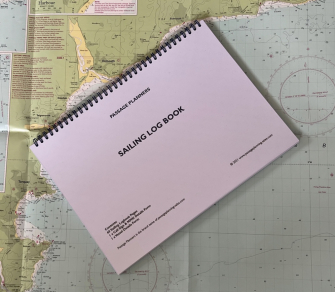
A further page allows entry of your vessel data, lifesaving equipment, radio and navigation equipment and shore contact details.
Our Sailing Log entry pages allow for entries as follows: Date, Departure and Arrival Ports, Tidal stream reference port, Weather forecasts, Skipper and crew details, Passage distance, time and engine hours totals and Cumulative totals, Departure and Arrival Port tides, Springs/neaps position, Magnetic and compass variation/dev. pre departure notes, engine checks and system checks.
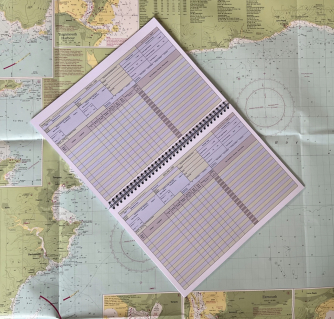
Passage entries include; Time, Latitude/Longitude, Course, Leeway, Log/Trip, Distance covered, Sail plan, Sail reef detail, Wind direction/strength, Weather, Engine status/log speed, Sea Condition and Remarks/Observations. In all, over 37 individual items.
Importantly, each log book entry page is individually numbered. This is important as the log book is a legal document.
The paper used throughout is 200 gsm. matt (ultra smooth) and suitable for writing on with pencil or ball point pen. Quick drying ink pens may also be used.
Inner front and back covers are 300 gsm. - Gloss antibacterial laminated
Outer front cover - Clear acetate
Outer rear cover - Opaque acetate
The outer front and back covers give superb protection to your log book.
The complete Sailing Log Book pages are punched on one edge (the 'binding edge') and securely bound together with a C shaped metal wire. (blue colour).
Wire bound documents can lay flat and pages can be turned easily, making it an ideal choice for your Sailing Log Book. Plenty of room for at least one to two seasons of sailing by most sailors.
All in all we consider that our Passage Planners Sailing Log Book is the most comprehensive sailing passage log book on the market with entry options to satisfy the most exacting skipper.
Please CLICK HERE to see more images and buy the Passage Planners Sailing Log Book
We also offer a sailing log book which can be downloaded and printed by you. Each page is individually numbered. Click on link below for full details.
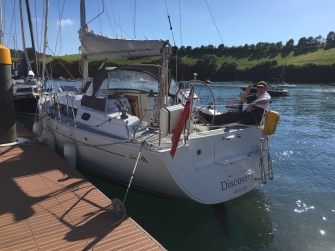
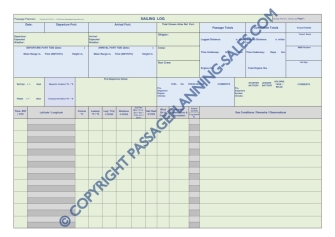
A relaxed skipper, safely moored in 'The Bag' in Salcombe harbour, Salcombe, Devon, England. 50º 14.61′ N, 03º 45.57′ W.
Leeway and Passage Planners Log Books
We have written an article relating to leeway and navigation. This can be seen Here. (opens in a new tab).
The article describes leeway in detail and its importance in navigation, particularly if your Passage Plan is of a longer distance.
Both of our log books have entries for Compass Course (Cº) and leeway. Leeway is expressed as Leeway ºP / ºS. Your calculated leeway ºP indicates that the wind/current causing the leeway is affecting your vessel from the Port side i.e pushing your vessel to Starboard. In this event your Compass Course (Cº) needs to be adjusted by subtracting the value of the leeway measured.
Leeway ºS means that the wind/current causing the leeway is affecting your vessel from the Starboard side i.e pushing your vessel to Port. In this event your Compass Course (Cº) needs to be adjusted by adding the value of the leeway measured.


